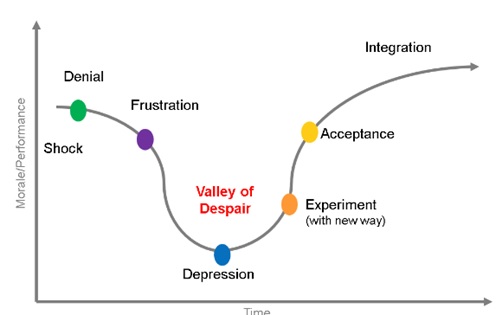In sales, we ask customers to change from their current products, switch to our products, and leave the known!
What’s so hard about that?
If you think about what we do in sales, it’s all about change. Not us, but our customers. They are currently buying from someone. Satisfied or not, they are buying from them and not from you. They are making their best choice based on the information they have.
As Ag Sales Professionals, we drive onto their farm that day and sell them on the idea of changing to our products or services. We ask them to stop doing what they are already doing, already spent money on, and probably told people about. In some cases, we are switching them off a product they are emotionally attached to. Tractor color might be an example. Ever hear a producer tell you, “I’m all green or red or blue on my farm?” Often there’s some emotion behind that. Ever compete against your customer’s mother? It’s not easy! One of my prospective customers was buying from a local company that his mother worked as the accounting manager. The headline for that competition could have read, “Outsider from big Ag competes against local mom!”. For him to change, meant a fairly serious emotional decision; not to mention tough conversations at the Thanksgiving dinner that year.
There’s an old saying, “Nobody likes to change.” First, I don’t think that’s true of everybody. In fact, there are two of the DISC profiles (D’s and I’s) who sort of embrace change. They get bored when life is too stagnant.
11 ways you can help your customers make the change to your products
- Make it easy: If it’s too difficult or complicated, customers pass or delay. Nine-page credit applications with three-step verifications are not easy.
Read: https://gregmartinelli.net/make-it-easy-keep-it-simple/
- Baby Steps! Make it sustainable: Massive changes are rarely sustainable. Break it down into smaller steps and get started. It’s a massive change for a 16-store retailer to replace their primary vendor in all stores. However, starting a small display or trial run in four stores is sustainable.
Read: https://gregmartinelli.net/biggest-loser-market/
- Use the change management process: You don’t have to become a Six Sigma Black Belt in Process Improvement, but understanding where your customer is on this graph will guide you on how you can help your customer get to “Acceptance” and the “Integration” stages of change.

Read: https://gregmartinelli.net/change-like-box/
- Apply the DISC model to your customer: As mentioned, certain people actually embrace change. However, you need to understand why the “D” or “I” profile like change. They embrace it for different reasons. More importantly, you really need to understand the other two “S” and “C” profiles. Why do they not like change? What are they afraid of when changing?
Read: https://gregmartinelli.net/hes-such-a-high-d/
- Apply the DISC model to yourself: After you understand how your customer feels about change, look in the mirror. You are in one of the four quadrants. Understand how your view is affecting your sales presentation.
- Are you a “Let’s build the plane in the air kind of person?” Then you need to understand how resistant to change your high “C” customer is to you.
- Are you a “Let’s all get consensus from everyone involved and have a meeting to decide kind of person?” Well, never mind, because your high “D” customer is checking their phone and not even listening to you.
- Live the change yourself if possible: This one really hits home for me. I sell sales training to salespeople. This means I have to actually do what I am selling. How convincing would I be if I didn’t use my own methods? Yet, often that’s exactly what we do as salespeople. This may not apply to every salesperson as you may not have a farm or livestock. However, if you do, you need to live by example and use your own products.
Read: https://gregmartinelli.net/3-ways-sell-like-hypocrite/
- Minimize or remove the risk: There is a risk in leaving the known supplier and buying from you (the unknown) supplier. Even if you are the most trusted supplier in the market, there is a risk. Ask! Here are a couple of great questions to uncover their fear of changing. Please don’t ask, “What are you afraid of?” That’s like calling them a “Chicken” for not wanting to change. Or worse, “What keeps you up at night?” The first thing that comes to everyone’s mind when asked that question, especially by someone you aren’t close is, “None of your business!”
Instead, ask, “When you have changed agronomy advisors in the past, how did it go?” Follow up with, “What went wrong?” Or “What concerns did you consider?” If they have never changed agronomy advisors in their life, then just rephrase the questions above to reflect it. For example, “You’ve been with your agronomy guy a long time! When you think about changing to someone else, what problems do you think would happen?” Then address the answer you get.
Coaching a salesperson recently, we were calling on a retail dealer, trying to become their primary product supplier. The dealer was listening and nodding along. The salesperson I was helping did a great closing style question, only to be met with resistance on money. To get started, it would take about $14,000 in inventory. Once shipped to the dealer, there were no returns. The risk was all on the dealer’s shoulders. This salesperson was asking the dealer to experiment with his own inventory money in order to see which products of the salesperson’s would actually sell. As an observer to the scene, it was easier to see. So, we took a break and brainstormed a solution. Coming back with an “Initial Consigned Inventory” offering. The dealer signed on.
Read: https://gregmartinelli.net/grain-prices-go-back/
- Tell a story: This is not just an amusing anecdote. It’s structured in the selling story format: Situation-Solution-Success
Read: https://issuu.com/joanviney/docs/18_fall_lo/32
9. Tie that story to an emotion: It’s the emotional component that makes the story remarkable and causes them to call you back.
10. Engage their trusted resource: As an Ag sales professional you try your hardest to be a trusted advisor. Great! Unless you are the thought leader in your industry and your market, you have one problem. They already have a trusted resource for your product line. If that current trusted resource is your competitor, then she has done her job and your efforts to become that customer’s trusted resource will be more difficult. However, if it’s not your competitor, find out who this producer looks to for expert advice. In our field, this might be the vet, a university professor, or one of the many experts that show up on weekend Ag shows. If they market grain, they are typically going to follow one of the grain market advisors that show up on national TV or Ag radio. Often, a producer subscribes to their grain marketing newsletter. Ask who they follow. Then, understand and stay up on how that expert is giving advice.
11. Become a trusted resource: Congratulations! Your customer now looks to you for that sage advice on what they should be doing. Don’t violate this trust. A lifetime of trust-building can be lost in seconds.
Read:
https://gregmartinelli.net/trust-the-ultimate-sales-tool/
and
https://gregmartinelli.net/trust-part-2-rebuilding-after-the-fall/




